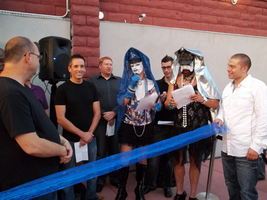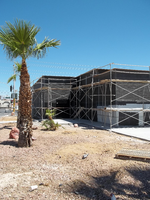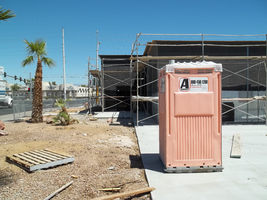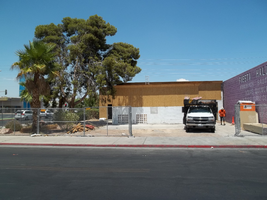Search the Special Collections and Archives Portal
Search Results

Tony Clark and others attend the Club Metro bar grand opening, Las Vegas, Nevada: digital image
Date
2013-07-20
Archival Collection
Description
From the Dennis McBride Photograph Collection (PH-00263) -- LGBTQ+ events and organizations in Las Vegas, Nevada -- Digital images file. Individuals identified by the donor, Dennis McBride: Tony Clark; Mother Loosey Lust Bea Lady [aka Tracy Skinner (Sin Sity Sisters of Perpetual Indulgence)]; unidentified man; unidentified Sister of Perpetual Indulgence
Image

Tony Clark and others attend the Club Metro bar grand opening, Las Vegas, Nevada: digital image
Date
2013-07-20
Archival Collection
Description
From the Dennis McBride Photograph Collection (PH-00263) -- LGBTQ+ events and organizations in Las Vegas, Nevada -- Digital images file. Individuals identified by the donor, Dennis McBride: Tony Clark; unidentified Club Metro owner; unidentified man; Mother Loosey Lust Bea Lady [aka Tracy Skinner (Sin Sity Sisters of Perpetual Indulgence)]; unidentified man; unidentified Sister of Perpetual Indulgence; Unidentified Latino Man
Image

Rob Schlegel, David Parks, and Bill Schafer attend the Club Metro bar grand opening, Las Vegas, Nevada: digital image
Date
2013-07-20
Archival Collection
Description
From the Dennis McBride Photograph Collection (PH-00263) -- LGBTQ+ events and organizations in Las Vegas, Nevada -- Digital images file. Individuals identified by the donor, Dennis McBride: Robert "Rob" Schlegel [gay]; David Parks [Nevada State Senator, District 7, Democrat (gay)]; William "Bill" Schafer [editor/publisher of the Las Vegas Night Beat (gay)]
Image
Sands Hotel interior shots of sportsbook, casino floor, waitresses, and general guests : video
Date
1994-08-29
Archival Collection
Description
B-roll footage of Sands Hotel sportbook, casino floor, Shangria-La Cafe (includes shots of food for menu), watiress interacting with guests, "Charlie Chaplin" costumed figure playing craps; . Original media Betacam, color, aspect ratio 4 x 3, frame size 720 x 486. From The Production Company Audiovisual Collection (MS-00930) -- Digitized audiovisual material file.
Moving Image

Rebuilding of Spotlight Lounge at new address, 975 East Sahara Avenue in Commercial Center, Las Vegas, Nevada: digital image
Date
2012-07-26
Archival Collection
Description
From the Dennis McBride Photograph Collection (PH-00263) -- LGBTQ+ events and organizations in Las Vegas, Nevada -- Digital images file. Notes from the donor, Dennis McBride: The Spotlight Lounge opened in April 1998, then was sold in 2011. There followed a major rebuilding of the bar, which reopened in 2012. The address was changed from 957 to 975 East Sahara Avenue.
Image

Rebuilding of Spotlight Lounge at new address, 975 East Sahara Avenue in Commercial Center, Las Vegas, Nevada: digital image
Date
2012-07-26
Archival Collection
Description
From the Dennis McBride Photograph Collection (PH-00263) -- LGBTQ+ events and organizations in Las Vegas, Nevada -- Digital images file. Notes from the donor, Dennis McBride: The Spotlight Lounge opened in April 1998, then was sold in 2011. There followed a major rebuilding of the bar, which reopened in 2012. The address was changed from 957 to 975 East Sahara Avenue.
Image

Rebuilding of Spotlight Lounge at new address, 975 East Sahara Avenue in Commercial Center, Las Vegas, Nevada: digital image
Date
2012-07-26
Archival Collection
Description
From the Dennis McBride Photograph Collection (PH-00263) -- LGBTQ+ events and organizations in Las Vegas, Nevada -- Digital images file. Notes from the donor, Dennis McBride: The Spotlight Lounge opened in April 1998, then was sold in 2011. There followed a major rebuilding of the bar, which reopened in 2012. The address was changed from 957 to 975 East Sahara Avenue.
Image

Rebuilding of Spotlight Lounge at new address, 975 East Sahara Avenue in Commercial Center, Las Vegas, Nevada: digital image
Date
2012-07-26
Archival Collection
Description
From the Dennis McBride Photograph Collection (PH-00263) -- LGBTQ+ events and organizations in Las Vegas, Nevada -- Digital images file. Notes from the donor, Dennis McBride: The Spotlight Lounge opened in April 1998, then was sold in 2011. There followed a major rebuilding of the bar, which reopened in 2012. The address was changed from 957 to 975 East Sahara Avenue.
Image

Rebuilding of Spotlight Lounge at new address, 975 East Sahara Avenue in Commercial Center, Las Vegas, Nevada: digital image
Date
2012-07-05
Archival Collection
Description
From the Dennis McBride Photograph Collection (PH-00263) -- LGBTQ+ events and organizations in Las Vegas, Nevada -- Digital images file. Notes from the donor, Dennis McBride: The Spotlight Lounge opened in April 1998, then was sold in 2011. There followed a major rebuilding of the bar, which reopened in 2012. The address was changed from 957 to 975 East Sahara Avenue.
Image

Rebuilding of Spotlight Lounge at new address, 975 East Sahara Avenue in Commercial Center, Las Vegas, Nevada: digital image
Date
2012-07-05
Archival Collection
Description
From the Dennis McBride Photograph Collection (PH-00263) -- LGBTQ+ events and organizations in Las Vegas, Nevada -- Digital images file. Notes from the donor, Dennis McBride: The Spotlight Lounge opened in April 1998, then was sold in 2011. There followed a major rebuilding of the bar, which reopened in 2012. The address was changed from 957 to 975 East Sahara Avenue.
Image
Pagination
Refine my results
Content Type
Creator or Contributor
Subject
Archival Collection
Digital Project
Resource Type
Year
Material Type
Place
Language
Records Classification
